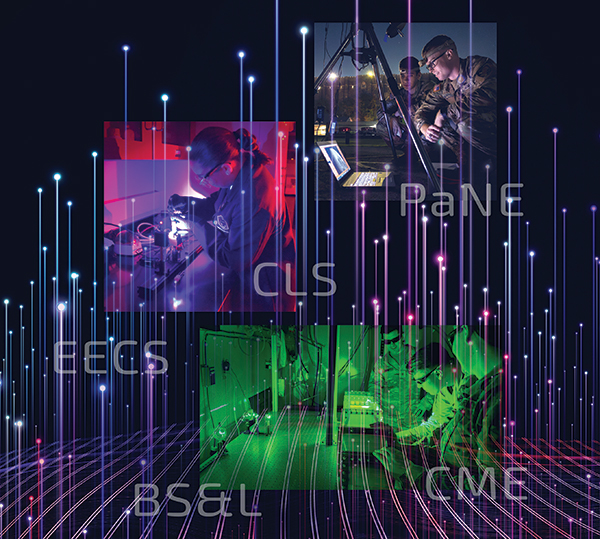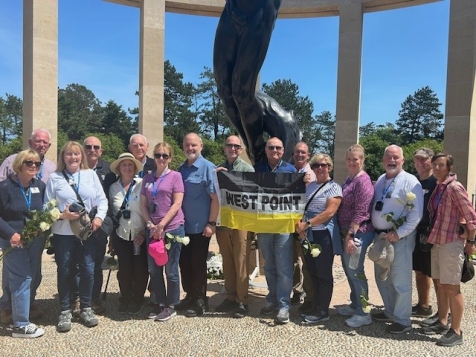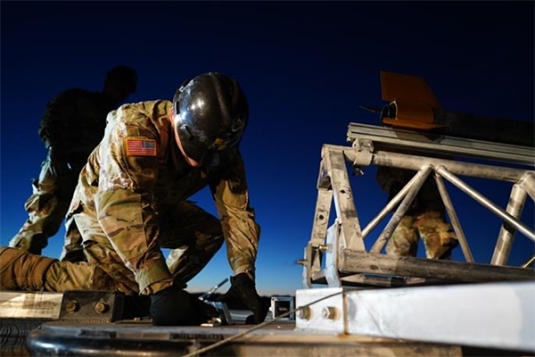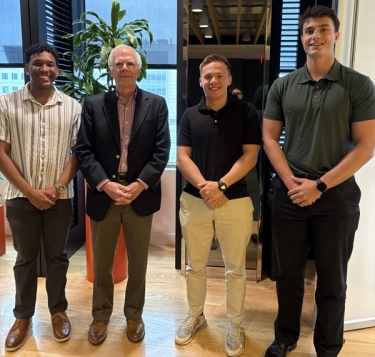In the 2023 Fall issue of West Point magazine, Lieutenant General Steven Gilland ’90 and Brigadier General Shane Reeves ’96 introduced the United States Military Academy’s annual intellectual theme for academic year 2023-24: “Innovation, Technology and the Future of National Defense.” For this issue, West Point magazine asked several academic departments to detail the cutting-edge work their cadets and faculty are doing that will impact the Army and nation in the future.
Department of Physics & Nuclear Engineering (PaNE)
The Army of the next war will shoot with munitions directed to their target with GPS-guided accuracy. The targets will be selected with space-based hyperspectral imaging sensors. The soldiers and vehicles will move with GPS-guided precision. Communications will extend well beyond range of site out to an arbitrarily large distance through satellite communication networks. The Army of the next war will shoot, move, and communicate with near limitless capability and infinitesimal precision because of the nation’s space-based capabilities.
Having an officer corps that understands the capabilities, vulnerabilities, and limitations of space-based assets is not a desire; it’s a necessity. The USMA House of PaNE is seeking to do exactly that by generating space-savvy graduates and the next generation of space domain experts.
The House of PaNE is seeking to expose a broad number of cadets to space through the Army Space Cadre Basic Course (ASCBC), hosted as a Military Individual Advanced Development (MIAD) program. This course exposes 40 cadets to the space domain, regardless of major. Another 20 seats are provided to science and engineering majors as a depth-of-study opportunity in order to provide a foundational background to research and major coursework. In addition to the ASCBC MIAD, the House of PaNE is opening a third science option for any cadet interested in learning more about the space domain. This new course, taught at the unclassified level, covers material similar to the ASCBC but with more math and problem-solving. These two programs will increase the number of space-savvy graduates to as many as 10 percent of each graduating class. This space-savvy group will understand the capabilities, vulnerabilities, and limitations of the nation’s space-based assets as they seek to maintain a persistent combat-ready Army.
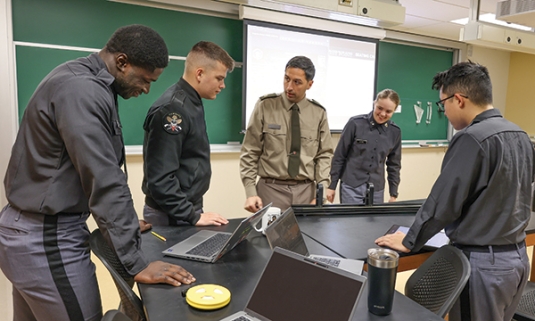
In addition to the broad exposure to the space domain PaNE provides to cadets, approximately 20 of its majors graduate each year with a degree in Space Science. This degree is very much a physics degree with a high level of problem-solving and exposure to traditional physics major subjects. In addition to the traditional physics major topics, each space science graduate studies orbital mechanics, astronautics, space weather, observational astronomy, remote sensing, and astrophysics. The breadth and depth of each of these semester-long topics produces small cohorts of officers that will someday feed improvements into next generation space-based equipment. Cadet Claire Lao ’26, a Space Science major, is working to construct a Langmuir probe that will answer questions about high latitude ionospheric effects on high latitude GPS signal distortions. She hopes to become an Army space operations officer someday, so she can “focus on providing troops with the space capabilities necessary to accomplish tactical and strategic missions.”
Another cohort of cadets departing USMA with space-savvy knowledge each year stems from the broad list of space research topics hosted by PaNE faculty. Cadets are working to better understand GPS signal degradation at high latitudes due to auroral activity in order to build better models of radiation field mapping near nuclear thermal propulsion engines for cis-lunar satellite operations, and they are studying data from the Parker Solar Probe to provide a better understanding of the impacts of solar weather on our space-based assets. Cadet Andrew Nguyen ’25, a Mechanical Engineering major, is leading a team of cadets to construct a functional CubeSat that will be launched as part of the Army’s rideshare program. Nguyen notes, “To succeed in the modern day multidomain fight, we must be able to understand the limitations and capabilities of everyone on our team.” Down the road, these future officers are going to generate disruptive technology in the procurement pipeline, tipping the scales to victory for U.S. military operations.
Anyone who has spent a day in the life of space science has heard the phrase “space is hard.” War is hard. The Army thrives in difficult environments. The Army will thrive in the next war by leveraging space for every opportunity it has to offer thanks to a generation of West Point commissioned officers who fully understand space-based limitations and vulnerabilities.
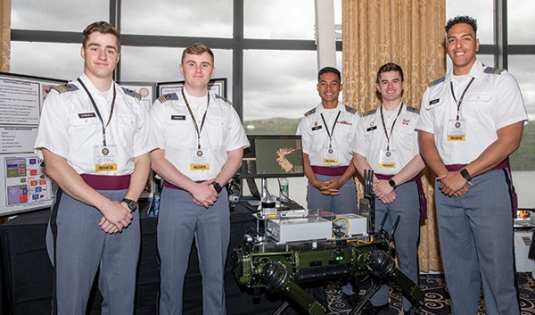
Department of Electrical Engineering & Computer Science (EECS)
Imagine the day when you see the new Cyber and Engineering Academic Center (CEAC) at West Point. You pull into its subterranean garage to park your electric vehicle at a designated parking space, lock your doors, and walk upstairs to experience the newest academic building at the Academy. After an awesome tour, you return to your vehicle to discover a full charge on the battery. While you were learning about the new facility, a robotic vehicle rolled up to your vehicle and autonomously plugged a cable into the charging port to top off your battery. While this might sound like science fiction, EECS cadets thought through this idea to design and build a prototype of this robotic platform. Their project, called Robotic Electric Vehicle Charger or REV-C, is one of many being worked on by cadets majoring in Computer Science, Cyber Science, and Electrical Engineering.
Every fall, cadets who are enrolled in XE401: Integrative System Design I, informally called EECS’s capstone course, are grouped into interdisciplinary and sometimes multidisciplinary teams to address challenging technical problems across disciplines. The candidate problems come to EECS through sponsors such as the U.S. Army Development Command, National Security Agency, Rock Island Arsenal, EECS faculty members, and even from the cadets themselves. For the next nine months, cadets apply the engineering design process and use project management tools to design, build, and test their projects. The culminating event for these teams is Projects Day in the Grand Ballroom of the West Point Club, where they get to present their work.
One group of cadets, advised by faculty members in the Photonics Research Center and sponsored by the U.S. Army Special Operations Command, is exploring a system that can transmit and receive encrypted data through directional optical methods. Radio transmissions are often located and targeted because they are omnidirectional transmissions. One solution is to use directional transmissions using invisible light. These cadets are working to send and receive encrypted digital data through more covert means to reduce the electromagnetic footprint. While present methods target soldier-to-soldier communications, future applications could include controlling unmanned systems.
Some EECS cadets are also enrolled in an independent study course and participating with other cadets to conduct research and solve problems outside of the prescribed design course. Three EECS cadets from three different year-groups recently teamed up together to design and build a system capable of generating a radio frequency emission for use by electronic warfare soldiers training for direction-finding tasks. Supported by the Cyber Research Center, this team competed and won the Warfighter Innovation in Science and Engineering Competition, a service academy-wide competition, in 2023.
Every EECS cadet enrolls in and dedicates their final year at West Point to a design sequence or pursues independent research to explore and demonstrate the skills they learned as an EECS major. Regardless of independent or group work, evidence of their successes is highlighted every year on Projects Day. Do not be surprised to someday see these EECS cadets’ ideas and project results used everywhere, especially at the CEAC.
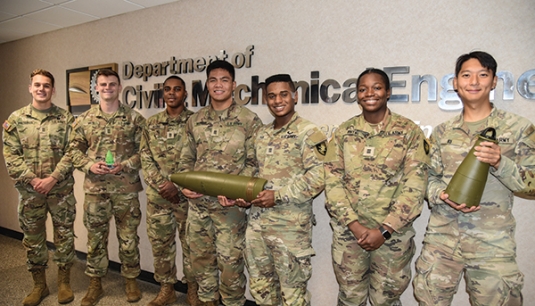
Department of Civil & Mechanical Engineering (CME)
CME has recently unveiled two pivotal projects, WAR and DTRA MRI, and each are poised to reshape the future of military innovation and defense strategy.
The WAR Project—Nestled within the historic Iowa Army Ammunition Plant (IAAAP), the backbone of the nation’s munition manufacturing since the 1940s, a project of paramount importance is underway. The Warehouse Automated Robots project, commonly called WAR by the CME and EECS cadets involved in this initiative, is working to modernize IAAAP, which has been operating at maximum capacity for decades, and to streamline its production. The WAR project seeks to introduce automation to the process, which would involve picking up rounds out of pallets and orienting them to be stamped, labeled, and machined.
Cadets are working to transform the 155 mm round production line into a state-of-the-art facility equivalent to modern factories. “The manufacturing of artillery shells is critical to national security, yet the process has largely remained untouched since World War II,” says Cadet Christopher White ’24, a Mechanical Engineering major. “This project hopes to automate key parts of the process to improve manufacturing efficiency, ultimately replenishing the United States’ strategic reserve of 155 mm shells.”
The cadets involved are not just students but future officers, and their hands-on experience with the WAR project equips them with invaluable skills in innovation, leadership, and problem-solving. “The cadets work with industrial equipment, real world vendors, and automation integrators, and the project forces them to adapt and see what real engineering is like,” says Daniel Dosher, an Assistant Professor and advisor with CME. “There’s rapid prototyping in every project, and in this one they must integrate with an existing manufacturing line that presents a lot of unique challenges, but that’s going to prepare them for their Army career.”
“The time, effort, and dedication put forth by the cadets on projects like this are not only great reflections on themselves but also illustrate the type of leaders that the Army can count on to help solve complex problems in often complicated situations.”
— 1SG (R) Bruce Trask, DTRA Contractor
The DTRA MRI Project—In the dynamic world of military defense, innovation isn’t optional; it’s essential. The U.S. Defense Threat Reduction Agency (DTRA), the University of Illinois Urbana-Champaign’s Beckman Institute, and CME have partnered in the hope of reshaping how the United States responds to chemical and biological threats.
Imagine scenarios in which troops must navigate deliberately contaminated areas or respond to accidents like explosions or chemical spills. CME cadets are working to ensure that, in such situations, the Army can effectively evacuate populations, shelter them in place, or move personnel to safety. The cadets are using magnetic resonance imaging (MRI) technology to study fluid flow, and their advanced simulations and models will allow the Army to explore numerous scenarios.
The cadets are constructing small-scale models of stadiums, cities, and other urban structures and using MRI to visualize fluid flow around these models. Cadet Adam Eckstein ’24, highlighting the groundbreaking nature of the project, says, “We get to lay the foundation for using an advanced technology to model something that’s never been modeled before.”
The significance of this research extends beyond the laboratory: for the Army, it directly informs decisions on chemical releases in battlefield scenarios; for cadets, it offers exposure to cutting-edge technology and the chance to apply classroom knowledge to real world problems. Dr. Andrew Banko, an Assistant Professor and advisor with CME, states, “They’re going to come out of this capstone design course knowing how to think pretty broadly about design and how to take on an open-ended project that goes beyond their regular curriculum.” Furthermore, as Army First Sergeant Bruce Trask (Retired), a DTRA contractor, says, “The time, effort, and dedication put forth by the cadets on projects like this are not only great reflections on themselves but also illustrate the type of leaders that the Army can count on to help solve complex problems in often complicated situations.”
The WAR and DTRA MRI projects are just two examples of the exceptional opportunities that are being brought to bear in the halls of West Point to push the boundary on innovation in the classroom and to develop future leaders who are ready to meet the needs of the Army and nation.
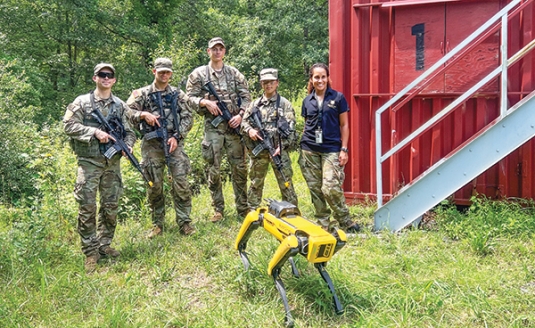
Department of Behavioral Sciences & Leadership (BS&L)
Engineering Psychology, a subdiscipline of psychology, is one of four academic majors in BS&L. Also known as Human Factors, Engineering Psychology is an applied science discipline that focuses on understanding human behavior and cognition in order to improve the design of technology. A multidisciplinary field with experts from a variety of backgrounds, it has applications in robotics, cyber, aviation, and the military. The goal of Engineering Psychology is to increase productivity and safety while enhancing the user experience through intuitive design, characteristics that are especially important in military contexts (given that ill-designed devices can cost lives). West Point is one of only a handful of academic institutions in the nation to offer Engineering Psychology as an academic major at the undergraduate level, and the major serves as one of the Army’s innovation testbeds for military technologies.
Two decades ago, USMA’s Engineering Psychology program focused heavily on the study of situation awareness and improving camouflage patterns. Supporting current Army modernization priorities, today’s Engineering Psychology cadets and faculty develop and evaluate new technologies and training, focusing on autonomy, cyber, modeling and simulation, and human-artificial intelligence (AI) integration. Some recent projects include integrating augmented reality in both training and multi-domain operations (e.g., IVAS, HoloLens, and BVI sand table), studying the impact of autonomous teammates on performance and integrating AI decision-aids into the military decision-making process. The Army and the academic community have repeatedly recognized BS&L’s Engineering Psychology cadets and faculty for their research efforts. The program’s senior faculty have received numerous Multi University Research Initiative, Defense Advanced Research Projects Agency, and U.S. Army Combat Capabilities Development Command awards in topics ranging from human-robot trust and team cohesion (Professor of Engineering Psychology Ericka Rovira), to explainable AI techniques (Associate Professor Robert Thomson), and to social cybersecurity (Associate Professor Aryn Pyke).
“Engineering Psychology has given me the opportunity to witness first-hand some of the cutting-edge technology currently in development for the Army.”
— 2LT Bethany Carter ’23
Through coursework in cognitive psychology, sensation and perception, and human factors engineering, cadets learn how autonomous systems impact attention, mental workload, decision making, teaming, and trust. With faculty mentorship, cadets apply these concepts in senior capstones and work in collaboration with Department of Defense scientists and engineers, as well as with researchers from universities and research enterprises. Second Lieutenant Kiersten Eggers ’23 writes of her experience, “From visiting ARL’s Grace’s Quarters to seeing the various robots the Army is developing for soldiers to presenting my senior honor’s thesis at the Human Robot Interaction Conference in Stockholm, the Engineering Psychology program has made me a better communicator and creative problem-solver, and it has enabled me to become exceptionally knowledgeable about the robotic platforms that my peers and I will work with during our careers as Army officers.”
The development and testing of the Integrated Visual Augmentation System (IVAS) demonstrates how knowledge of the visual system learned in sensation and perception coursework was applied to a senior capstone. “Engineering Psychology has given me the opportunity to witness first-hand some of the cutting-edge technology currently in development for the Army,” writes Second Lieutenant Bethany Carter ’23, whose capstone involved wearing the IVAS and investigating the impacts of different color modes on vision. “In conducting this capstone, I was able to use the information I learned in my classes and apply it to [the] real-life Army when IVAS showed up to my unit last month!” she says.
Concomitantly, cadets and faculty are increasingly engaged in researching cyber human factors. Cadet Darby Horne ’24 is currently applying coursework in human computer interaction, cognitive psychology, and human factors engineering to her senior capstone, which investigates the use of map visualizations to make cyber and electronic warfare threats more salient to military leaders during tactical planning. “It’s fascinating to see everything I have learned come together in a real-world application!” she says.
The modern military is characterized by increasingly automated and data-intensive systems that are literally changing every day, given the advances being made in AI and autonomous systems. The exposure that Engineering Psychology cadets have to these systems prepares them to not only embrace using these technologies but to innovate within the field to maintain the Army’s superiority over the nation’s adversaries.
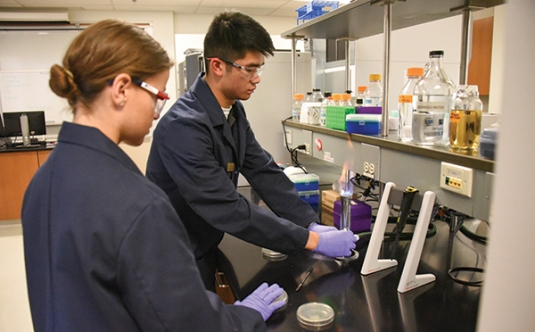
Department of Chemistry & Life Science (CLS)
CLS is a vital partner in providing science and engineering depth to USMA graduates. It supports this effort by leveraging the newly renovated Bartlett Hall and its outstanding laboratory facilities, world class faculty, and a network of civilian and government research partnerships. The model that CLS employs, coined “teaching through research,” combines classroom experience with complex, lab-based problem-solving on a variety of Department of Defense (DoD) challenges. Cadets perform research in areas that resonate with both them and the Army: keeping soldiers safe, saving lives, and solving the most difficult technical challenges for tomorrow’s force. This integrative experience provides intellectual development that extends beyond the classroom and promotes cognitive maturity that is paramount for the future success of our Army. The outcomes are impressive and have improved the graduating population over the last 10 years in two important ways. First, for the population of cadets who attend medical school upon graduation (two percent of the graduating class by law), conducting research and publishing in peer-reviewed journals (70 cadet co-authored publications since 2018) has drastically improved their chances for acceptance at the very best medical schools. USMA graduates have seen increased enrollment at Harvard, Stanford, Dartmouth, Georgetown, and other top-tier medical schools, and they have gone on to provide the very best care to the nation’s soldiers and veterans. Second, the “teaching through research” model has enabled the exponential increase in technical scholars who, upon graduation, attend graduate school and receive advanced degrees in science and engineering. The increase in technical scholars, which now averages 28 CLS graduates per year over the past three years, provides the Army with a population of young officers who have advanced understanding and the ability to solve complex problems. They also have keen awareness of the technology that our Army will use on the future battlefield, and they are familiar with the technology the Army will face from any potential adversaries: artificial intelligence, advanced biological threats, exploitation of data, and more.
Cadet Eddie Chen ’25 offers the following testimony regarding his experience as a CLS major: “My research experience at West Point centers around investigating energy storage systems, with a focus on nanomaterial development for battery components, such as electrodes and separators. Through my research, I have interacted with mentors, attended lectures, completed an internship at a national laboratory, and communicated results through conferences. I have learned that I can leverage my platform as a cadet and future officer to partake in these unique research opportunities, showing me that service and research are not mutually exclusive. These experiences have also influenced my goals to become an Engineer officer. All these experiences have enhanced my classroom experiences and provided me with additional tools to solve the complex problems I will face as an Army officer.”
The Center for Molecular Science (CMS) within CLS is the key enabler supporting the “teaching through research” model. CMS enables CLS’s mission through administrative, legal, and budget support that streamlines and facilitates the success of cadet and faculty research. Three lines of research effort—protection, energy, and materials—directly support the most pressing DoD challenges. Cadets who are focused on the protection effort study bacteriophage therapeutics, pathogenic bacteria and viruses, metal organic frameworks, and DNA aptamers, all with the goal of exploiting science and engineering to increase soldier survivability against the latest threats on the battlefield. Those studying energy challenges focus their work on the optimization, storage, and control of energy to improve efficiency and reduce risk to Army formations. Some of the energy areas in which cadets are currently engaged include flowable electrodes, energy awareness, battery technology, and the modeling of such systems. Lastly, cadets studying materials are researching novel solutions to improve the hardware used by our Army. CLS work in this research effort includes nanomaterials for energy storage, threat detection, and mitigation, as well as work in propellants, munition degradation, and countermeasure development.
The “teaching through research” model has proven to be a successful way to promote deeper learning and develop agile thinkers who, as officers, will successfully lead the Army against the daunting challenges facing the nation.
Margin of Excellence
While the technical expertise and work comes from the cadets, the product produced in the end would not be possible without financial support from various sources, such as the Reimbursable Program funds and donor-sponsored gift funds. As an example, EECS’s REV-C project was sponsored by a donor through gift funds. Many of the other projects mentioned are supported by funds received and administered by host department’s associated research centers. To learn about future funding opportunities, please contact the West Point Association of Graduates’ Development Office.
West Point magazine would like to thank COL Will Wright ’99, MAJ Jordan Laughlin ’11, CPT Victoria Gramlich ’13, CPT Carter Kelly ’13, Dr. Matt O’Banion, and Dr. Jon Malinowski from the Department of Geography and Environmental Engineering; COL Tina R. Hartley ’92 from the Department of Mathematics; COL Bryan Gibby ’93 from the Department of History, and Michael Diaz from the West Point Museum for their assistance with this article.
What do you think? Click here to answer 3 questions.

